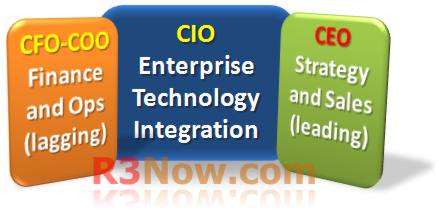The CIO role in business has been changing almost as quickly as technology itself. In the past focusing on business processes and automation was enough to satisfy the business needs for operational excellence. As long as they did so successfully, the CIO received carte blanche, often having large budgets and significant latitude in applying them. However, those days are quickly fading.
Today, many IT departments and IT organizations are becoming internal vendors to internal customers with “charge backs” to the internal organizations. They are becoming little more than internal cost centers and overhead to the rest of the business. This re-alignment of the technology organization is creating significant budget pressures, leading to staffing gaps.
Global Markets Are Being Dynamically Shaped and Altered
Modern technology has lowered the barrier to entry for new competitors by allowing international outsourcing, greater agility, quicker product design to market, and specialized focus on niche markets causing more market fragmentation and specialization. Customers have a wide variety of information from sellers and the Internet about products, design, services, options, pricing, and availability. Things are more dynamic than ever.
Because of the pace of change, focusing on best practices and internal process improvement, or even extending processes, is no longer enough. Business can rarely (if ever today) integrate, automate, and streamline to achieve marketplace success. To one degree or another, nearly every competitor is already doing this or is quickly headed in that direction.
Business complexity and the breakneck pace of change turns yesterday’s breakthrough technology into today’s commodity. Vendors are modestly integrated into the extended supply chain, all the way from raw materials to end customer delivery. Customers are more sophisticated and have more options than ever through the Internet. Competitors have incorporated similar technology throughout their entire process chains by integrating, automating, and accelerating their processes. As a result, business demand on technology simultaneously creates new opportunities and new struggles.
Today’s CIO Is Being Asked to Deliver More With Less
While many technology projects still address business process improvement, cost reductions, and efficiencies, the team is pressured to integrate the sales side of the business as well. More than ever, all levels of IT decision makers feel the pressure to deliver business results focused on customer acquisition, customer retention, revenue growth, and innovation. What this means is that the CIO or key IT decision maker must focus on being a bridge to the different sides of the business like never before. The CIO who can properly partner with and integrate into the business as a whole will rise above their peers and be successful. Those who cannot will find budgeting and staffing more and more difficult. Today’s CIO has a big job. As this Booz Allen insight article from 2002 [FN1] noted, to succeed they must:
- participate in corporate planning and strategy sessions,
- align and integrate technology initiatives in terms the business understands — speeding products to market, enabling growth, reading costs and risks, etc.,
- make the case for technology spend and budgets, in business terms, with competing C-level executives, and
- develop internal knowledge and collaboration networks.
To make this transition, the successful CIO must chart a course between the two sides of the business that the CFO (or COO) and CEO (or President) represent. These two executive roles are a counterbalance, which the successful CIO must learn to navigate. Without that integration of the CIO role into both sides of the business the IT area and IT functions are quickly seen as very expensive cost centers to be cut.
The CFO (and COO) Focuses on Business Processes and Financial Performance
The CFO role is focused on company finances and company health. These would be a company’s lagging indicators in terms of business metrics, where both operations and finance intersect. If the company is doing well, then these financial or operational lagging indicators will reflect this after the entire process is complete. These results only show up after customer cash is collected and vendor bills are paid together with employee salaries, fixed expenses, variable expenses, etc.
Ultimately, these lagging indicators show whether a business is healthy and headed in the right direction. However, the danger with a pure focus on operations, processes, and financial metrics is you must wait until you have already arrived at your destination to figure out if you took the right path. In today’s global economy, any mistakes could be disastrous.
To survive in today’s global economy, a business must know early on where to make course corrections to stay on track. Business no longer has the luxury of waiting until the financial results are in to figure out if things are headed in the right direction.
For most CIOs and IT managers, they have almost exclusively focused on this entire domain. Nearly all technology activities and certainly most SAP implementations focus on these areas exclusively.
The CEO Focuses on Strategy, Business Growth, Sales, and Marketing
The CEO role is about future strategy, sales, marketing, and business growth– or leading indicators. If the company has:
- new customer prospects in a healthy sales pipeline,
- a steady stream of customers being converted from the pipeline into orders,
- a growing order backlog while the fulfillment process performance is static or improving,
- existing customers buying more or higher-margin products and services, and
- a low percentage of customer churn,
then these leading indicators of future growth and prosperity are promising. These kinds of leading indicators demonstrate future company performance but have been largely lacking from the technology equation.
Often through the interaction among the sales, marketing, and engineering/product development areas, the CEO also bears the responsibility for new products or services.
Today, the extent of nearly all leading indicator initiatives is around CRM applications. Unfortunately, CRM applications are little more than gigantic contact management systems with some built-in analytics. SAP’s CRM application, as well as other top-tier vendors, does offer a measure of sales accountability and sales process discipline that has been lacking. However, few if any of the CRM applications actually provide real technology benefits to improve the sales process, or promote customer retention. They may modestly improve customer acquisition because of the amount of data and customer-centered intelligence they can provide, but this is proving to be marginal.
Where Does the CIO Role Fit in Today’s Global Economy?
CIO’s have traditionally focused on process improvement, automation, and items related to a company’s fiscal health and performance. Few technology leaders or technology projects have addressed the leading indicator side of the business equation beyond installing CRM applications. But today’s CIO will have to change that. More than ever, the CIO must focus on the integration of the leading and lagging indicators.
The successful CIO will become the “integration glue” between the CFO and the CEO.
In properly aligned organization, the CIO role and the IT staff must be business-centric first, and they must address business events from both a lagging and leading indicator perspective. The most successful CIO will become the bridge between the CEO and the CFO, and thereby integrate business leading and lagging functions with technology. In other words, the successful CIO must find ways to not just integrate operations, finance, and sales– but do so in such a way that technology investment and technology spend becomes focused more aggressively on the demand side (customer sales and innovation) rather than on the supply side (operations, processes, and automation).
This graphic shows not only the proper CFO/COO, CIO, and CEO level alignment, but also the burden that the most successful CIO and IT decision maker carry. Future CIO success with technology in the business requires a holistic focus on business demand. The CIO role is becoming larger, and yet more difficult at the same time that the IT organization is under more and more financial and budget scrutiny. What this means is that if the CIO, IT Director, or other IT decision makers do not have an MBA or other formal business training themselves, they may wish to enhance their IT departments and IT organizations with true business analysts who also know technology (or can learn technology).
IT organizations and technology budgets that fail to address both sides of the business equation (lagging AND leading indicators) experience the following:
- significant budget cuts,
- a move into “maintenance mode,”
- the organization support model’s conversion to an internal vendor to internal customers with “charge-backs” for services provided to the organization,
- loss of partnership with the business.
As the business as a whole pushes back on what they see as a very expensive IT department they will find their own internal ways around the budget hits from IT. Internal company departments will avoid budget hits from these “charge-backs” by doing things themselves whether that means manual processes or developing some measure of internal IT autonomy in some of their tech savvy departmental employees.
What Can IT Decision Makers Do to More Aggressively Address Business Needs?
There are a number of approaches you can take and a number of requirements you will need for a changing job role.
- Engage the CFO/COO and the CEO in discussions about supporting their business needs.
- Find ways to actively and directly integrate part of the IT staff into key business departments. For example, should the Finance, Operations, and Sales departments each have their own dedicated IT staff members? Or how do you take a limited staff and create a responsibility matrix to maximize business attention on these key departments?
- Invest in business analysts with business degrees or a business focus, who know or can learn the key technologies to support the business.
- Define and develop a technology strategy execution team consisting of at least one senior level VP or Director from Finance and Operations (appointed by the CFO / COO), Sales, Marketing, and Engineering (appointed by the CEO), and Technology (appointed by the CIO).
- Have the strategy execution team work together with any of their own key resources to define top level KPIs for IT to business integration.
- Revisit current KPIs, departmental goals, and metrics to ensure that technology and IT are aligned to these important business measurements.
- Use the underlying metrics and business goals for the KPIs as the source for both reporting and technology initiatives.
[FN1] Boochever, J., Park, T., Weinberg, J., CEO vs. CIO: Can This Marriage Be Saved? Booz Allen Hamilton, Strategy Business Online, July 17, 2002, retrieved online February 6, 2010 at http://www.strategy-business.com/article/20571
======================
Part 1: What is the Proper Relationship for the CIO, CEO, and CFO?
In the first part of this series, we looked at the changing business landscape and what it means to the CIO, IT Director, IT Manager, or other key technology decision makers. From a high level the current global business competition, as well as economic issues, directly affect the C-level executive requirements and the CIO–CFO–CEO dynamic. This article reviewed how and where the CIO role is coming under tremendous pressure and how to change the current dynamic by more appropriately partnering with the CFO and the CEO. This partnership is a critical business bridge between lagging business indicators of business financial and process health on the CFO–COO side of the business house and the leading indicators of sales and product or service pipelines on the CEO side of the business house.
Part 2: CIO, CFO, and CEO Alignment – Why ROI is Lacking from Today’s System Landscape
The second part was an overview of the current system landscape and its focus on business processes and the emerging trend of focusing on the customer. This piece also looked at the future business landscape and how the technology focus and direction will be permanently changed, no matter what happens with the economy and global competition. Because the technology marketplace (business consumer) is becoming more sophisticated and more attuned to business/technology alignment, the IT dynamic is going through a structural change. The whole technology sector is slowly moving away from the operational excellence value proposition to the customer focus and innovation areas of the business. Few of the consulting companies and few of the application vendors see this change, and they are doing little to address it.
Part 3: Changing the Direction of SAP, ERP, and IT Applications to Focus on the Customer and Innovation
The third part in the series looked at current technology landscapes and how they are aligned, and then looked at future technology landscapes. A brief review of the supply and demand side of business shows that unless you have lots of customers (demand) to fill a bigger pipeline (supply), then your business model collapses. While it is hidden during good economic climates, any disruption in those economic conditions which fails to fill the capacity pipeline points out the glaring insufficiency of the operational focus to technology. During any economic disruption, or any reduction in demand from customers for your products or services, the current technology model falls apart.
Part 4: Future Technology Landscape Alignment for the CIO, IT Director, or Key IT Decision Maker
The final part of the series looks at the emerging technology landscape and what the future holds. It lays out an emerging technology landscape model, which has some realignment and components already in use by some of the world’s most successful companies. The article explores a new alignment of technology with the customer facing processes, and the use of social or collaboration tools across the enterprise with a clear business objective. The driver for the future change will be that the business does not see the revenue generation prospects of technology. Rather, they fail to see the possibilities of promoting customer retention, customer acquisition, innovation, and marketplace analytics. The new technology model looks to change that dynamic.






